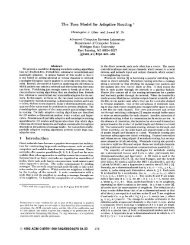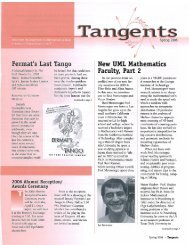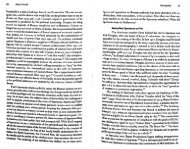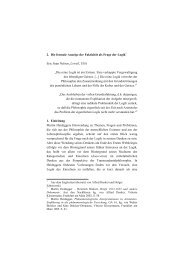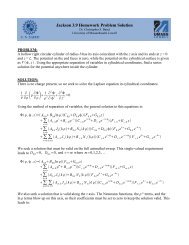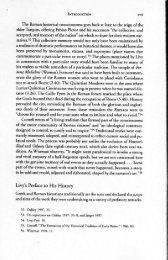167 Paul John Frandsen EGYPTIAN IMPERIALISM* By way of ...
167 Paul John Frandsen EGYPTIAN IMPERIALISM* By way of ...
167 Paul John Frandsen EGYPTIAN IMPERIALISM* By way of ...
Create successful ePaper yourself
Turn your PDF publications into a flip-book with our unique Google optimized e-Paper software.
<strong>Paul</strong> <strong>John</strong> <strong>Frandsen</strong><br />
<strong>EGYPTIAN</strong> <strong>IMPERIALISM*</strong><br />
<strong>167</strong><br />
<strong>By</strong> <strong>way</strong> <strong>of</strong> justification for his protracted digression on Egypt Herodotus<br />
claims that the geo-physical characteristics <strong>of</strong> the land and the customs<br />
and behaviour <strong>of</strong> its population are in most respects the opposite <strong>of</strong> those<br />
<strong>of</strong> other peoples and countries; and in contradistinction to his mention<br />
and discussion <strong>of</strong> the latter Egypt is dealt with as a separate entity.<br />
In a <strong>way</strong> this view <strong>of</strong> the old civilization has survived until the present<br />
day - reflected, partly, in the ever growing curiosity <strong>of</strong> the general public<br />
and in the closed discipline <strong>of</strong> Egyptology.<br />
However, in the last decade an increasing number <strong>of</strong> Egyptologists have<br />
become aware <strong>of</strong> the necessity to reconsider and reassess what former<br />
generations <strong>of</strong>scholars established as firmly rooted concepts and incontestable<br />
"facts", the incentive being less the constant flow <strong>of</strong> new material<br />
than precisely the recognition that the subjects <strong>of</strong> study and the results<br />
obtained are to a considerable extent the product <strong>of</strong> the mind <strong>of</strong> the<br />
investigator. It is no secret that Egyptologists are not in the forefront <strong>of</strong><br />
the modem transformations <strong>of</strong> the humane and social sciences, but we<br />
find some excuse in the fact that the field is still in its infancy; the language<br />
is imperfectly understood; the material remains are in a variety <strong>of</strong> <strong>way</strong>s<br />
very unrepresentative; in short, Egyptologists use all their efforts in an<br />
attempt to acquire an adequate command <strong>of</strong> a broad spectrum <strong>of</strong> very<br />
basic sub-disciplines.'<br />
However one may account for the change - and the matter is <strong>of</strong> course<br />
more complex than these few words indicate - it is the case that by<br />
means <strong>of</strong> new theoretical assumptions and methods borrowed from other<br />
fields Egyptologists have indeed embarked upon a process <strong>of</strong> what one<br />
might call subversion.<br />
On the occassion <strong>of</strong> this symposion,therefore, I should like to join the<br />
colours by <strong>way</strong> <strong>of</strong> a discussion <strong>of</strong> the Egyptian Empire.<br />
While the existence <strong>of</strong> an empire during at least some part <strong>of</strong> the New<br />
*) I am grateful to Pr<strong>of</strong>essor Torgny Save-5oderbergh for allowing me to quote from<br />
his unpublished paper "Aspecu <strong>of</strong> ancient Egyptian relations with Nubia and the<br />
Sudan" and to Pr<strong>of</strong>essor J. R. Harris for revising the English text <strong>of</strong> the original<br />
version <strong>of</strong> this paper.
168 169<br />
Kingdom is generally recognized, a new case has been made out recently<br />
for a kind <strong>of</strong> hold over Syria and Palestine by the pharaos <strong>of</strong> the 12th dynasty,"<br />
Having enumerated "the most striking facts"3 Posener concludes<br />
that "there emerges the impression <strong>of</strong> domination by the pharaohs, uneven<br />
and interrupted, no doubt, but on the whole vigorous. Its precise<br />
nature still eludes US".4<br />
Let us briefly look at his arguments. "The sources at our disposal are<br />
evasive", he says, "and do not permit us to settle the question"! (whether<br />
there was a political domination/empire).<br />
He shows that the use <strong>of</strong> the-Execration Texts "as a source for political<br />
history is very hazardous", though the texts' omission - among the potential<br />
enemies <strong>of</strong> Egypt - <strong>of</strong> precisely those towns "in which (...) the<br />
presence <strong>of</strong> Egyptians made itself especially strongly felt" "may be significant".6<br />
There remains, then, the actual Egyptian material found in these<br />
places, first and foremost statues <strong>of</strong> Middle Kingdom <strong>of</strong>ficials found in<br />
Megiddo, Ugarit, etc.<br />
Arguing by analogy with a similar group <strong>of</strong> statues <strong>of</strong> Middle Kingdom<br />
<strong>of</strong>ficials found at Kerma in Nubia and by reference to the other inconclusive<br />
material he arrives at the conclusion quoted a moment ago."<br />
To put it bluntly, this is an instance <strong>of</strong> the typical dagger-handle <strong>way</strong><br />
<strong>of</strong> reasoning, and, as it happens, HeIck has demonstrated beyond doubt<br />
that both the Nubian and the Asiatic material have been found in archaeological<br />
contexts that cannot be dated earlier than the Hyksos period.f<br />
Consequently, the Egyptian domination over Syria and Palestine must be<br />
regarded as a red herring.<br />
The Egyptian occupation <strong>of</strong> Lower Nubia during the Middle Kingdom<br />
is as certain as the purpose and content <strong>of</strong> this domination is disputed''<br />
and in what follows I shall therefore confine myself to the New Kingdom,<br />
the period <strong>of</strong> the Empire, as it is called in all textbooks. Within this span<br />
<strong>of</strong> time the bulk <strong>of</strong> material drawn upon will be from the 18th dynasty,<br />
that is - roughly speaking - from 1500-1300 B.C.<br />
During this period Egyptian expansion was directed towards Asia and<br />
Nubia, the two traditional foci <strong>of</strong> the country's foreign policy. Scholars<br />
usually refer to the outcome <strong>of</strong> this process in terms <strong>of</strong> occupation, but,<br />
as will be seen, the measures adopted by the Egyptians in the two areas <br />
their scope and execution - were in certain basic respects so different,<br />
that the grouping <strong>of</strong> them under such a heading is hardly justifiable. In<br />
terms <strong>of</strong> territorial expansion the peak was reached in the reign <strong>of</strong> Thutmosis<br />
III who succeeded in extending the southern frontier all the <strong>way</strong><br />
down to the 4th cataract, while parts <strong>of</strong> Syria and Palestine were brought<br />
into some state <strong>of</strong> dependency on Egypt. In both areas the form and content<br />
<strong>of</strong> their relationship with Egypt were subject to modification and<br />
development, but in that I am not immediately concerned with the history<br />
<strong>of</strong> the individual components <strong>of</strong> this relationship as such, the following<br />
survey <strong>of</strong> what I consider the most salient features will present a state <strong>of</strong><br />
affairs, which - as a whole - may have existed only at a given point<br />
during the New Kingdom, or indeed may not have existed at all. This<br />
procedure, <strong>of</strong> course, raises at least one very important problem which<br />
will be discussed later.<br />
Let us now tum our attention to Nubia, where the Egyptians managed<br />
to accomplish an almost perfect Egyptianization. 10<br />
At the political and administrative level the expansion meant the introduction<br />
<strong>of</strong> the Egyptian administrative technique. The country was<br />
divided into two regions: Wawat, embracing lower Nubia down to Semna,<br />
immediately south <strong>of</strong> the second cataract, and Kush, the deep south.<br />
Monuments and especially prosopographical analyses show that the<br />
government <strong>of</strong> Nubia was modelled on that <strong>of</strong> Egypt. At its head was the<br />
Viceroy, who was responsible only to the king on an equal footing with<br />
the vizier. And again corresponding to the organizational role <strong>of</strong> the<br />
viziers <strong>of</strong> Upper and Lower Egypt, Wawat and Kush were then administered<br />
by two deputies, and both regions were subdivided into settlements<br />
or administrative districts, each under the control <strong>of</strong> a mayor. The<br />
government comprised the usual departments, witness such titles as Overseer<br />
<strong>of</strong> the Treasury, Overseer <strong>of</strong> Granaries, etc.<br />
At all levels <strong>of</strong> administration the majority <strong>of</strong> the <strong>of</strong>ficials seem to have<br />
been Egyptians, but local chiefs even holding important <strong>of</strong>fices were by<br />
no means rare. Like in Syria and Palestine the Egyptians took great pains<br />
to ensure their loyalty. To this end the most effective means was the<br />
practise <strong>of</strong> taking the sons <strong>of</strong> the indigenous rulers as hostages to Egypt,<br />
where the education at the court <strong>of</strong> Pharaoh was so successful that,<br />
allegedly, they forgot their own language.'! However, in that the aim <strong>of</strong><br />
Egyptian policy in the two areas was not the same, the Nubian youths<br />
were apparently brought up as potential members <strong>of</strong> the Egyptian ruling<br />
class.P i.e, having "job possibilities" in Nubia as well as Egypt. In support<br />
<strong>of</strong> this contention I should like to draw attention, first to the well known<br />
fact that these "children <strong>of</strong> the royal training school" 12 a not only had<br />
their native names replaced by an Egyptian one, but, more significantly,<br />
had their tombs cut in a wholly Egyptian style. Already in the early part<br />
<strong>of</strong> the 18th dynasty we find tombs which are completely indistinguishable<br />
from those <strong>of</strong> true Egyptian <strong>of</strong>ficials.P The second point actually needs<br />
further elaboration before it can find general acceptance, but it cannot be<br />
denied that, as from the reign <strong>of</strong> Amenophis II, men <strong>of</strong> Nubian extraction<br />
figure conspicuously among the most trusted <strong>of</strong>ficials <strong>of</strong> Pharaoh. Thus<br />
the tutor <strong>of</strong> Tuthmosis IV - whose name shows him to be a Nubian (or
172 173<br />
ally repressive - and ideologically more intensive form, The Egyptian<br />
expansion towards Nubia is generally attributed - first and foremost to<br />
the presence, in huge quantities, <strong>of</strong> gold, its product par excellence.P<br />
Now, in a recent study Janssen 34 has shown that there are very good<br />
reasons for assuming that the output <strong>of</strong> the Egyptian mines was a great<br />
deal larger than that <strong>of</strong> Nubia - though the reverse situation has ranked<br />
as another <strong>of</strong> the basic "facts" in Egyptology. If that is true, it gives rise<br />
to a number <strong>of</strong> highly important questions, such as: was this the case also<br />
before the reconquest? or, did the Egyptians expect the Nubian mines to<br />
be richer - and easier to work - than their own? or was the higher output<br />
in Egypt due to the discovery <strong>of</strong> new mines? a more extensive use <strong>of</strong><br />
the known sources? a depletion <strong>of</strong> the Nubian mines? or a combination <strong>of</strong><br />
these and other factors? Thus posed none <strong>of</strong> the questions is likely ever to<br />
be answered, but they do compel us to put the problem <strong>of</strong> why the Egyptians<br />
went into Nubia on an entirely new basis.<br />
The fact, however, that during the Middle <strong>of</strong> the 18th dynasty the<br />
jurisdiction <strong>of</strong> the viceroy was extended to include the three southernmost,<br />
gold-producing nomes <strong>of</strong> Egypt itselfl s - I would emphasize that<br />
Nubia and old Egyptian territory were unified under his charge - is in my<br />
opinion a clear indication in favour <strong>of</strong>the view that Nubia (Wawat) - in this<br />
period at least-- was a fully integrated part <strong>of</strong> Egypt, though - for the<br />
specific reason mentioned a moment ago, it was not on an entirely equal<br />
footing with, say, the grain-producing Lower Egypt.<br />
I quoted Kempi" for a situation "where the temple was a new foundation<br />
on a hitherto non-urban site and where it was to remain the principal<br />
or even sole reason for a settlement's existence", and according to him<br />
"the most obvious category in (this) situation is the royal mortuary<br />
temple." The implications <strong>of</strong> the first part <strong>of</strong> this statement have already<br />
been referred to and I shall now use the latter as the starting-point for<br />
some further remarks on the settlement policy.<br />
First it must be emphasized that this sentence (where it was to remain<br />
the principal or even sole reason for a settlement's existence) is not an<br />
expression <strong>of</strong> a general acceptance <strong>of</strong> the idea that in the development <strong>of</strong><br />
human society ideological motives should be given priority over material<br />
factors. Rather it is in keeping with the prevailing opinion that would<br />
attribute, for instance the marked increase in the production, which<br />
begins to show up as from the 3rd dynasty, to a more rigorous and accomplished<br />
interpretation <strong>of</strong> the concept <strong>of</strong> kingship, resulting in the<br />
setting up <strong>of</strong> large scale funerary establishments consisting <strong>of</strong> a pyramidtomb,<br />
a mortuary temple and endowments - mainly in the form <strong>of</strong><br />
new settlements - for the maintenance <strong>of</strong> the cult <strong>of</strong> the dead king.<br />
And this development, in turn, is <strong>of</strong> course but one stage in a process<br />
where, unfortunately, the interaction <strong>of</strong> material and ideological elements<br />
is little known.<br />
What the statement does imply is that the nature <strong>of</strong> this particular<br />
relationship between settlement and temple is such that as soon as the<br />
upkeep <strong>of</strong> the cult is brought to a stop the settlement is disestablished.<br />
This point is illustrated by Kemp in his discussion <strong>of</strong> the relationship<br />
between the pyramid and mortuary temple <strong>of</strong> Sesostris II and the town<br />
<strong>of</strong> Illahun; but does it apply to the Nubian scene?<br />
While it is probable, as mentioned earlier, that a temple economy<br />
was used as the basic unit in the organization <strong>of</strong> the economic administration<br />
<strong>of</strong> Nubia, the motives behind the planning <strong>of</strong> the Egyptianization<br />
program are not easily apparent. On the one hand we have the<br />
fortified settlements <strong>of</strong> Lower Nubia the distribution <strong>of</strong> which is dearly<br />
correlated with the location <strong>of</strong> the gold mines and the need to control<br />
the river-traffic; and on the other hand, as stated by Kemp, "the<br />
apparently nonecologically based distribution <strong>of</strong> temple towns into<br />
the impoverished area between Batn-el-Hagar and the Third Cataract<br />
looks suspiciously like the result <strong>of</strong> an over-assessment <strong>of</strong> agricultural<br />
potential based on a false understanding <strong>of</strong> the process <strong>of</strong> nature."37<br />
In other words, we do not know whether the fortified temple settlements<br />
were instruments <strong>of</strong> a policy primarily aimed at creating a stable<br />
background, say, for the working <strong>of</strong> the gold mines, or were aimed at<br />
the development and subsequent exploitation <strong>of</strong> Nubia as a whole; in<br />
short, whether the settlements belong to the level <strong>of</strong> ideology or economy.38<br />
However, it is obvious that the presence <strong>of</strong> a number <strong>of</strong> important<br />
gods, including - among the gods <strong>of</strong> state - a divine form <strong>of</strong> the living<br />
king, must have made a certain ideological impact, though its range and<br />
scope are the subjects <strong>of</strong> some controversy. Some scholars would subscribe<br />
to Trigger's assertion when he writes: "While the worship <strong>of</strong><br />
reigning monarchs may have been carried to further extremes architecturally<br />
in Nubia than it was in Egypt, it is wrong to view these cults<br />
as being surreptitiously or experimentally introduced among the<br />
credulous barbarians <strong>of</strong> Egypt's Nubian empire. Statues <strong>of</strong> Amenhotep<br />
III and Ramesses II were objects <strong>of</strong> worship in Egypt no less than in<br />
Nubia."39<br />
This is undeniable; divine forms <strong>of</strong> those kings were indeed worshipped<br />
in both countries." but the special form <strong>of</strong> the worship in<br />
Nubia was not restricted to architecture. The material pertaining to the<br />
cult <strong>of</strong> a divine form <strong>of</strong> the reigning king (mainly Ramesses II) has been
190<br />
Streitwagen, damit verbunden aber durch Verbreitung Ihrer Art der Weltbetracht·<br />
ung, den Anstoss zu der geistigen Entwicldung der 18. Dynastie gegeben."<br />
86. For the following see Elster, op. cit., ch, 3 and 4.<br />
87. This is disputed by Goddard, "Anthropology: the Limits <strong>of</strong> Functionalism",<br />
in Blackburn (ed.) , Ideology in Social Science, 1972, pp. 61-75.<br />
88. Cf. Elster, op, cit., ch. 4.<br />
89. Cf. Wilson, The Burden <strong>of</strong> Egypt, 1951, p. 95 ff. Helck, Geschichte des alten<br />
A'gypten, 1968, ch. 6 and E. Martin-Pardey, Untersuchungen zur iigyptischen<br />
Prouinzialuerwaltung bis zum Ende des Alten Reiches, 1976.<br />
90. The classic study in this respect is. however, Heick. Der Einfluft der MilitiirfiiJarer<br />
in der 18. agyptischen Dynastie, 1939.<br />
PART IV<br />
The Neo Assyrian Empire
330 331<br />
competence and consistency, to consolidate their rule over this much<br />
more heterogeneous territory. The attempt eventually failed, so far as the<br />
Assyrians were concerned, with Nineveh falling in 612 B.C., but the<br />
greater part <strong>of</strong> the empire was inherited entire by the Chaldaean kings <strong>of</strong><br />
Babylon.<br />
Many <strong>of</strong> the historical events <strong>of</strong> these three centuries were recorded in<br />
sculptures: stone slabs, carved in low relief, which decorated the walls <strong>of</strong><br />
the royal palaces. Modem displays <strong>of</strong> these sculptures are unavoidably<br />
misleading as they al<strong>way</strong>s consist <strong>of</strong> fragments - several slabs long, perhaps,<br />
but nonetheless fragments - <strong>of</strong> what were very complicated schemes<br />
<strong>of</strong> decoration including paintings also and embracing entire palaces. Each<br />
<strong>of</strong> these was essentially the creation <strong>of</strong> one Assyrian king, built in his<br />
capital-city.<br />
In the early ninth century Ashurnasirpal, an important king <strong>of</strong> the first<br />
phase <strong>of</strong> expansion, turned the small provincial town <strong>of</strong> Kalhu into a new<br />
capital-city for himself. Over a century later Tiglath-pileser III, who<br />
inaugurated the second phase <strong>of</strong> expansion, built himself a new palace,<br />
also at Kalhu. Shortly afterwards Sargon built a new capital-city on a<br />
fresh site in the neighbourhood, which he named after himself, Dur<br />
Sharrukin. Hin son Sennacherib, late in the eighth century at the start <strong>of</strong><br />
his reign, shifted the capital to another nearby city, Nineveh. His son<br />
Esarhaddon made arrangements to move back to Kalhu, and his son<br />
Ashurbanipal returned to Nineveh. We therefore have a magnificent<br />
succession <strong>of</strong> palaces, each the memorial <strong>of</strong> one man.<br />
This memorial status is plain from inscriptions commemorating the<br />
building projects. They hardly mention the administrative convenience or<br />
political motives that may sometimes have been involved. They concentrate<br />
instead on the personal achievement <strong>of</strong> the king responsible. Ashurnasirpal<br />
states it clearly."<br />
"I founded therein a palace as my royal residence and for my<br />
lordly pleasure for eternity. I decorated it in a splendid fashion...<br />
May a later prince restore its weakened portions and restore my<br />
inscribed name to its place. Then Ashur will listen to his prayers.<br />
He must not forsake my mighty palace, my royal residence, <strong>of</strong><br />
Kalach, nor abandon it in the face <strong>of</strong> enemies. He must not<br />
remove the doors, beams, or knobbed nails <strong>of</strong> bronze from it and<br />
put them in another city in another palace .. , He must not block<br />
up its door. He must neither appropriate it for a warehouse nor<br />
tum it into a prison . .. He must not allow it to disintegrate<br />
through neglect, desertion, or lack <strong>of</strong> renovation. He must not<br />
move into another palace, either within or without the city, instead<br />
<strong>of</strong> my palace."<br />
And so on: a list <strong>of</strong> all the dreadful things that eventually did happen to<br />
Ashurnasirpal's palace at the hands <strong>of</strong> his practically minded successors,<br />
and to their palaces in their tum.<br />
Each palace, <strong>of</strong> which the sculptures were an integral part, had its<br />
individual character. They have features in common, so that we can see<br />
a logical sequence <strong>of</strong> development and sometimes imitation, but they were<br />
designed for different kings each <strong>of</strong> whom was anxious to prove his own<br />
superiority. The king's names, titles, and achievements were written repeatedly<br />
in both conspicuous and concealed places, and frequently assert<br />
that he had done what his predecessors had failed to do. The palace was a<br />
massive corpus <strong>of</strong> personal propaganda.<br />
The sculptures and paintings, apart from those which had a magical or<br />
ornamental function, concentrate in accordance with Mesopotamian tradition<br />
on the achievements <strong>of</strong> the king. We see him worshipping, standing to<br />
receive his courtiers or processions <strong>of</strong> tributaries, administering justice,<br />
and winning or celebrating victories which may be over men, wild animals,<br />
or natural obstacles. Assyrian art employs various traditional Mesopotamian<br />
conventions: an example is the treatment <strong>of</strong> the human face, where<br />
types may be distinguished but we can seldom recognize individual portraiture.<br />
No significance need be attached to such stylistic conventions<br />
except in so far as they demonstrate continuity with the past. There are<br />
<strong>of</strong> course stylistic and other developments within Assyrian art over the<br />
centuries; the most important, from our point <strong>of</strong> view, is that the scenes<br />
become more complicated so that the latest ones are the most informative.<br />
There is, however, no great change in their ideological content, in the<br />
assumptions and attitudes illustrated by them.<br />
The king is invincible, but not superhuman. In each composition, or<br />
in each unit <strong>of</strong> a strip-cartoon composition, he normally appears once and<br />
once only, like anyone else. He is the most important figure, but he is<br />
normally the same size as other people until Esarhaddon's conquest <strong>of</strong><br />
Egypt, after which he tends to be slightly bigger. He may seem to be no<br />
more than one in a crowd; there are exceptions in certain kinds <strong>of</strong> composition,<br />
but they merely reflect stylistic difficulties which can equally result<br />
in the king being smaller than other people (Fig. 1): once, for instance, he<br />
appears as a dwarf riding a pony. The opposition which the king overcomes<br />
sometimes seems unworthy <strong>of</strong> him, but at other times he faces<br />
dangerous problems which enhance his ultimate victory. The sculptures<br />
seem reliable in what they include: thus Sargon and earlier kings take a<br />
more active part in battle than later kings; there are also pictures <strong>of</strong> campaigns<br />
in which, as we happen to know, the king did not participate, and<br />
he is not shown as participating. On the other hand the sculptures exclude<br />
undesirable subjects such as Assyrian casualties: some <strong>of</strong> these were in
332<br />
advertently included, through uncritical use <strong>of</strong> the stylistic convention <strong>of</strong><br />
chariots running over a dead enemy, on one embossed door fitting," but<br />
instead <strong>of</strong> being scrapped it was relegated in the practical Assyrian <strong>way</strong> to<br />
the most inconspicuous position available. Mass-production, coupled with<br />
poor supervision, as well as provincial arrogance or ignorance, also led to<br />
various breaches <strong>of</strong> etiquette, but they were generally tolerated so long as<br />
they did not infringe the prerogatives <strong>of</strong> royalty.<br />
The king, besides being invincible, has god on his side. In normal<br />
circumstances he needs no justification for what he does. He is high priest<br />
<strong>of</strong> the god Ashur, whose glory he proclaims throughout the world. Early<br />
ninth-century kings are accompanied by a god in mid-air; divine insignia<br />
go with the army; the gods <strong>of</strong> defeated nations acquiesce. It was the king's<br />
duty to protect his realm, the realm <strong>of</strong> the god Ashur, from the powers <strong>of</strong><br />
chaos which the enemy represented. Sennacherib was even shown, according<br />
to one ancient description <strong>of</strong> a picture which does not survive,<br />
helping the gods in their own struggle against primeval Chaos." The theme<br />
was epitomized in the design <strong>of</strong> the stamp-seal used by royal <strong>of</strong>ficials: it<br />
shows the king killing a lion, one <strong>of</strong> the wild animals which threatened the<br />
security <strong>of</strong> the realm such as human enemies did (Fig. 2). A comparable but<br />
simpler design, the king drawing a bow, was adopted for the coinage <strong>of</strong><br />
imperial Persia. The gods naturally rejoiced in the defeat and death <strong>of</strong><br />
those who opposed the Assyrian king, and artists recorded the events<br />
with a triumphant relish for detail.<br />
The king ruled, however, a peaceful and well-ordered state. His noteworthy<br />
achievements, within the boundaries <strong>of</strong> his empire, spoke for<br />
themselves and there are relatively few useful illustrations <strong>of</strong> them. If a<br />
tributary state was turned into an imperial province under an Assyrian<br />
governor, it became part <strong>of</strong> the realm <strong>of</strong> Ashur; it ceased paying tribute<br />
and paid tax instead; this payment was a routine affair, and not worth<br />
illustrating. There is a strong contrast with the Persepolis sculptures, with<br />
their emphasis on the international nature but internal cohesion <strong>of</strong> the<br />
Persian empire. There are some Assyrian pictures that show engineering<br />
operations at home, but idyllic scenes, such as the countryside near Nineveh<br />
(Fig. 3), tend to be inserted marginally in compositions that really deal<br />
with other subjects.<br />
This attitude towards the king - the justice <strong>of</strong> his cause and the unquestioning<br />
loyalty <strong>of</strong> his people - is one aspect <strong>of</strong> Assyrian ideology<br />
illustrated by the sculptures; there was nothing exceptional about it in the<br />
ancient Near East. The Assyrian attitude to the world outside the empire<br />
was more complicated, reflecting in a practical fashion the realities <strong>of</strong> imperial<br />
power and responsibility. Foreign states were grouped in categories<br />
and treated accordingly; the distinction between the different categories<br />
333<br />
was flexible, and circumstances naturally varied in <strong>way</strong>s that the sculptures<br />
do not indicate, but the general rules are tolerably clear.<br />
Some foreign kingdoms were recognized as independent equals. In the<br />
second millennium B.C. there had been several great powers which recognized<br />
each other's independence, and Assyria itself eventually joined<br />
this select group. Similarly, in the middle <strong>of</strong> the ninth century, we find<br />
the king <strong>of</strong> Assyria posing as brother <strong>of</strong> the king <strong>of</strong> Babylon: the pair were<br />
shown shaking hands (Fig. 4) after the Assyrian had intervened, by invitation<br />
according to Assyrian sources, in a Babylonian civil war. Later,<br />
when Tiglath-pileser III conquered Babylonia around 730, he continued<br />
to recognize Babylonian pretensions to independence, taking the throne<br />
himself. This meant accommodating two kingdoms within one empire, and<br />
the recalcitrant problem <strong>of</strong> how best to do this was an important factor<br />
in the collapse <strong>of</strong> Assyria a century or so later.<br />
Another state recognized as independent was Urartu, beyond the mountains<br />
on Assyria's northern border. The peaceful albeit nervous relationship<br />
established between Assyria and Urartu is illustrated by a mid-seventhcentury<br />
picture in which two Urartian ambassadors witness an Assyrian<br />
triumph (Fig. 5).<br />
Elam, in southern Iran, had similar status. There is a picture <strong>of</strong> Elamite<br />
princes competing unsuccessfully with the Assyrian king in a lion-hunt,<br />
which may well have been a specifically royal activity.! There is also a<br />
picture <strong>of</strong> Elamite ambassadors, who have brought an insulting message,<br />
being detained not without respect at the Assyrian court.t On one occasion<br />
the Assyrians supplied Elamites with food during a famine - one <strong>of</strong><br />
the few clear examples from Mesopotamia <strong>of</strong> food affecting international<br />
relations.' In the middle <strong>of</strong> the seventh century war broke out between<br />
Assyria and Elam, and the Elamite king, who had sent the insulting<br />
message, was killed in battle; maltreatment <strong>of</strong> the Elamite king's head<br />
(Fig. 6) was justified by reference to this message, though even pro-Assyrian<br />
Elamites evidently regarded it as a breach <strong>of</strong> international good<br />
manners.P After their victory the Assyrians presented the Elamites with a<br />
new king, who had been a political refugee in Assyria; he was shown being<br />
introduced to the Elamite people by an Assyrian <strong>of</strong>ficer (Fig. 7), and<br />
greeted with songs and music while bodies from the battle floated down<br />
the river nearby. The Assyrians, then, were representing themselves as<br />
friends and liberators. Subsequent troubles, however, altered the Assyrian<br />
attitude towards Elam, and it was treated more harshly.<br />
Egypt too was probably accepted as an independent power before the<br />
brief seventh-century Assyrian occupation. There is a ninth-century<br />
picture <strong>of</strong> tribute from Egypt,' but this may have been either an idle<br />
boast or a reference to the status <strong>of</strong> <strong>By</strong>blos, a possible Egyptian protec
334 335<br />
torate in Lebanon. There is a suggestion in one text that the Assyrians,<br />
when they did occupy Egypt, made a point <strong>of</strong> replacing the foreign<br />
Nubian kings with presumably more popular native rulers.l" and pictures<br />
draw a distinction between the two groups <strong>of</strong> people (Fig. 8), though this<br />
may be an accident <strong>of</strong> preservation.<br />
A second category <strong>of</strong> foreign state consisted <strong>of</strong> those which were not<br />
equals <strong>of</strong> Assyria but nonetheless did not owe allegiance to the Assyrian<br />
king. Various sculptures show wars with states <strong>of</strong> this kind. There is a<br />
ferocious battle, with the atrocities that have been customary in warfare<br />
throughout history. The enemy town mayor may not be burnt, and the<br />
king then reviews the prisoners, men, women, and children. There is rough<br />
justice, but there are no elaborate executions. The people mayor may not<br />
be transferred, for security or other reasons, to another area <strong>of</strong> the empire;<br />
if so they are replaced, as texts tell us, with other captives from elsewhere.'!<br />
Pictures show them under escort, but reasonably well treated.<br />
A third category included people who denied allegiance both to the Assyrian<br />
king and to the ideals <strong>of</strong> urban civilization which the Assyrians and<br />
other states upheld. These were the wild tribes and villagers <strong>of</strong> hill and<br />
desert; they were liable to be exterminated.<br />
The next category consisted <strong>of</strong> tributary states. The king was shown<br />
receiving their gifts, sometimes on campaign and sometimes at home, in<br />
formal conventionalized compositions. In the seventh century, after the<br />
second great phase <strong>of</strong> imperial expansion, this theme disappeared from Assyrian<br />
art. One reason, perhaps, is that the very expansion <strong>of</strong> the empire<br />
had greatly reduced the significance <strong>of</strong> tribute. Once most <strong>of</strong> the old<br />
tributary states had been incorporated into the empire, with others as<br />
well, the new tributary states in distant Iran and Anatolia had nothing<br />
remarkable to <strong>of</strong>fer.<br />
Disobedience or rebellion by a tributary state attracted punishment.<br />
A famous example is Sennacherib's capture <strong>of</strong> Lachish. After the fall <strong>of</strong><br />
the town, the local dignitaries were tortured to death publicly. It was<br />
hoped that this would help ensure peaceful conditions in future, and it<br />
was a scene <strong>of</strong> this kind that the Urartian ambassadors were shown. The<br />
surviving population <strong>of</strong> Lachish was moved elsewhere, and we see<br />
prisoners from this and other campaigns employed as forced labour on<br />
public works in Assyria (Fig. 9). Some nomadic and correspondingly less<br />
manageable Arabs were treated far more severely: after the battle, when<br />
the Assyrians reached their encampment, even the women were assaulted<br />
and killed (Fig. 10).<br />
These, then, are the different categories <strong>of</strong> foreigner which we can<br />
distinguish in the pictures. In one respect, however, they are all treated<br />
alike: tremendous care is taken to represent them, their cultural and some<br />
times physical characteristics, and the landscapes in which they live (Fig.<br />
11). We do occasionally see the Assyrians making fun <strong>of</strong> foreigners, as<br />
when rival claimants to the Elamite throne were forced to act as waiters,<br />
but the sculptures remind me far more frequently <strong>of</strong> Oppenheim's remarks<br />
referring to the account <strong>of</strong> Sargon's eighth campaign: n<br />
"The text addresses itself at an audience really interested in learning<br />
about foreign peoples, their <strong>way</strong> <strong>of</strong> life, their religion and customs.<br />
In fact one feels tempted to draw a parallel between the priests<br />
and citizens <strong>of</strong> Ashur <strong>of</strong> 714 Be and the audience which listened<br />
to the logoi <strong>of</strong> the predecessors <strong>of</strong> the Ionian logographers only a<br />
century or so later in Asia Minor .. , The attitude just described<br />
indicates an audience sure <strong>of</strong> itself, deeply imbued with a conscious<br />
tradition <strong>of</strong> native origin but, at the same time, aware <strong>of</strong> the<br />
existence <strong>of</strong> other traditions without reacting to them so intensely<br />
as to evolve patterns <strong>of</strong> either aggression or fossilizing self-isolation."<br />
This receptive attitude is implicit in the sculptures. I would mention a<br />
further specific example. The palaces were decorated partly with magical<br />
figures which kept a<strong>way</strong> disease and bad luck. In the ninth century these<br />
figures are traditional Assyrian types (Fig. 12), which subsequently become<br />
less frequent. They are joined, and largely replaced, by others<br />
borrowed not only from Babylonia, the traditional home <strong>of</strong> wisdom and<br />
magic, but also from the western provinces, which contributed the sphinx.<br />
Similarly we find Assyrian kings sitting happily on Phoenician furniture<br />
(Fig. 13), and announcing that they have built themselves palaces in the<br />
Hittite style <strong>of</strong> architecture.P We are given the impression that they<br />
viewed the world with enormous self-confidence, and were therefore<br />
willing to adopt anything which appealed to them, regardless <strong>of</strong> its origin.<br />
While the narrative sculptures tell us a great deal about the Assyrians,<br />
they were not as prominent in the Assyrian palaces as they are now in<br />
books about Assyrian civilization. To appreciate the relative significance<br />
<strong>of</strong> different types <strong>of</strong> sculpture in the palaces, we have to reconstruct in<br />
our mind's eye the architectural context. We do not know what any Assyrian<br />
building looked like in its entirety, but we can, generalizing with all<br />
appropriate reservations, build up a composite picture for palaces <strong>of</strong> the<br />
ninth and eighth centuries.<br />
The exterior walls are largely plain, but for magical decoration at the<br />
entrances and along the crenellations. This is all that the common people<br />
<strong>of</strong> Assyria normally saw, a massive but fairly simple structure inside the<br />
citadel. The sheer size <strong>of</strong> some <strong>of</strong> the magical figures, however, which<br />
i
336<br />
weighed up to sixteen tons, must have been intended to impress human<br />
as well as supernatural visitors (Fig. 14).<br />
Those with business inside the palace entered through a gate-chamber<br />
which was decorated internally, at least in the provincial palace <strong>of</strong> Til<br />
Barsip, with narrative pictures <strong>of</strong> a military campaign. The great gate <strong>of</strong><br />
the city <strong>of</strong> Ashur, and the entrance to the imperial barracks at Nineveh,<br />
also held military trophies. The palace gate-chamber opened into a huge<br />
outer courtyard surrounded by <strong>of</strong>fices; these were, so far as we know, undecorated.<br />
Beyond lay another courtyard with more <strong>of</strong>fices but also having,<br />
on one side, the magnificent facade <strong>of</strong> the royal throneroom, together<br />
with side access to further state apartments.<br />
Above the throneroom doors were brilliantly coloured pictures in<br />
glazed brick, showing the king at worship. There is a standard composition:<br />
the king in duplicate, on either side <strong>of</strong> a sacred tree above which floats a<br />
winged disk carrying the figure <strong>of</strong> a god. The scene has been variously<br />
interpreted, but seems to show the king in some relationship with powers<br />
<strong>of</strong> the earth and sky, for whose favour he as high priest and shepherd <strong>of</strong><br />
his people was primarily responsible. In any case, it is a ritual scene,<br />
emphasizing the king's religious duties. Anyone looking through the great<br />
central door <strong>of</strong> the throneroom could see the self-same scene on the wall<br />
opposite, and it recurred in various contexts elsewhere (Fig. 15).<br />
The throneroom facade was dominated, lower down, by magical figures<br />
such as colossal human-headed winged bulls. On either side, however,<br />
leading the eye towards the throneroom doors, were smaller slabs showing<br />
the king with a few attendants receiving groups <strong>of</strong> people. Once these<br />
were courtiers bringing furniture and other equipment for some court<br />
ceremony. More <strong>of</strong>ten there were processions <strong>of</strong> people bringing or<br />
preparing to bring tribute. Tribute was again the constant theme <strong>of</strong> obelisks<br />
which were erected, probably in fairly public places, during the ninth<br />
century: the tributaries come naturally from the periphery <strong>of</strong> the Assyrian<br />
empire, but it does sometimes seem that they have been selected for their<br />
remoteness and for the exotic goods they have with them.<br />
The places decorated by these sculptures were as far as the ordinary<br />
subject could hope to penetrate, unless we may imagine an occasional<br />
guided tour, into the royal palace. We have, as it happens, one list <strong>of</strong> the<br />
people such a palace was meant to impress, the 70,000 odd guests at<br />
Ashumasirpal's housewarming party: 14 nearly all <strong>of</strong> these were Assyrian<br />
subjects, a few represented states which either were or may have been<br />
tributary, and there were none at all from major independent powers. The<br />
image these public monuments present is plain: a king, devoted to his religious<br />
duties, to whom gifts come from the far ends <strong>of</strong> the earth for the<br />
greater glory <strong>of</strong> the god Ashur and his servants. Military themes were not<br />
Fig.1 Sennacherib enthroned at Lachish (BM 124911).
Fig. 2 Assyrian royal seal (8M 50790).<br />
Fig.3 Deer in Sennacherib's Nature Reserve at Nineveh (BM 124824).<br />
Fig. 4 Meeting between kings <strong>of</strong> Assyria and Babylon. Reign <strong>of</strong> Shalmaneser III.<br />
(Iraq Museum).
Fig.5 Urartian ambassadors (the short men in caps) watching the punishment <strong>of</strong><br />
anti-Assyrian rebels. Reign <strong>of</strong> Ashurbanipal (BM 124802).<br />
Fig.6 Recognition <strong>of</strong> Elamite king's head, held by Assyrian soldier to right <strong>of</strong> tent.<br />
Reign <strong>of</strong> Ashurbanipal (BM 124801).
Fig. 7 Assyrian <strong>of</strong>ficer presenting Elarnites with new king. Reign <strong>of</strong> Ashurbanipal<br />
(BM 124802).<br />
Fig. 8 Assyrian campaign in Egypt, with captured Nubian soldiers (left) and Egyptian<br />
civilian prisoners (right). Reign <strong>of</strong> Ashurbanipal (BM 124928).
Fig. 9 Western prisoners working in Assyrian quarry. Reign <strong>of</strong> Sennacherib<br />
(BM 124821).<br />
Fig.10 Assyrians assaulting Arab women. Reign <strong>of</strong> Ashurbaoipal (BM 124927).
Fig. 11 Assyrians recording details <strong>of</strong> a campaign. Reign <strong>of</strong> Sin-shar-ishkun? (Glasgow<br />
Art Gallery and Museum, Burrell Collection 28/33).<br />
Fig.12 Assyrian protective genie from palace <strong>of</strong> Ashurnasirpal (BM 98064).
Fig. 13 Ashurbanipal and consort at picnic (BM 124920).<br />
Fig.14 Facade <strong>of</strong> Sennacherib's palace (?). Reign <strong>of</strong> Ashurbanipal (BM 124938).
Fig. 15 Ashurnasirpal portrayed twice, in ritual pose, with protective genies behind<br />
and winged disc above (BM 124531).<br />
Fig.17 Incident from Assyrian-Elarnite battle (BM 124801).<br />
Fig.18 Eunuchs acting as labourers for Sennacherib (BM 93019).
338 339<br />
excluded, and may <strong>of</strong> course have had a wider circulation on textiles and<br />
small objects. The emphasis, however, was on peace, Pax Assyriaca, rather<br />
than on war.<br />
Inside the throneroom, at least in Ashurhasirpal's palace, there was a<br />
greater range <strong>of</strong> subject-matter. The king, besides appearing in ritual<br />
scenes opposite the main entrance and behind his throne, was also shown<br />
in formal compositions with his courtiers. There were many magical<br />
figures. Over half the sculptures, however, were narrative scenes <strong>of</strong>military<br />
expeditions in different lands or occasionally <strong>of</strong> hunts. Some kings do<br />
specifically mention how magnificent their military narrative sculptures<br />
were, and they doubtless impressed some foreigners with the irreversible<br />
progress <strong>of</strong> Assyrian arms, but entry to the throneroom must in practice<br />
have been largely restricted to men already connected with the Assyrian<br />
court. Propaganda is better exemplified in the reception-wing <strong>of</strong> the<br />
palace <strong>of</strong> Sargon.<br />
The identification <strong>of</strong> this area as a reception-wing is largely dependent<br />
on the architectural plan (Fig. 16) but the sculptures help to explain it. It<br />
was approached from the throneroom court (VIII) by a passage (10) in<br />
which were depicted rows <strong>of</strong> tributaries from east and west; we may<br />
suppose that such people, or their leaders, did indeed come this <strong>way</strong>, and<br />
there are other instances in the Assyrian palaces <strong>of</strong> illustrative decoration<br />
<strong>of</strong> this kind. They emerged into an open space (III) with the receptionwing<br />
to one side. Its facade was again decorated with magical figures, and<br />
with the king and his attendants. Through the doors they could again see<br />
sculptures representing the king, a feature <strong>of</strong> door<strong>way</strong>s throughout this<br />
building. On entering the room (8), they found that the king was depicted<br />
presiding over the torture and execution <strong>of</strong> important rebels, a clear piece<br />
<strong>of</strong> deterrent propaganda. These salutary scenes led their eyes to a small<br />
door<strong>way</strong> at the throne end <strong>of</strong> the room, which communicated with<br />
private apartments (6, 11); through this door the king emerged to receive<br />
them in person.<br />
An adjoining reception-room (4) was suitable for the entertainment <strong>of</strong><br />
guests. They will not have been surprised to find here exactly the same<br />
pictures <strong>of</strong> execution. A few guests may have had the privilege <strong>of</strong> entering<br />
a smaller room (7) nearby, surrounded by more congenial scenes <strong>of</strong><br />
hunting and feasting; the king as usual was represented opposite the door,<br />
and this is where he himself probably sat.<br />
Pictures <strong>of</strong> Assyrian military achievements were restricted, in Sargon's<br />
palace, to other anterooms and reception-rooms on the less accessible side<br />
<strong>of</strong> the reception-wing, and elsewhere. They were presumably used to a<br />
greater extent by Assyrian courtiers. Similarly, in all Assyrian palaces, the<br />
king's achievements in the hunting field were restricted mainly to the<br />
more private state apartments and the approaches to them. Even when<br />
hunting scenes appear in a throneroom, as they do in Ashurnasirpal's<br />
palace, they are the two narrative sculptures closest to the royal throne.<br />
This illustrates an important feature <strong>of</strong> Assyrian narrative art, its entertainment<br />
value: it is full <strong>of</strong> anecdotes and reminiscences, and it was meant<br />
to be enjoyed as much as admired. The king's personal achievements in<br />
the hunt were a theme likely to give particular pleasure to him himself,<br />
and they were sited accordingly. A courtier could look at a campaign<br />
scene, perhaps with an explanatory caption, and remember battles in<br />
which he himself had participated (Fig. 17). This was preaching to the<br />
converted rather than propaganda.<br />
At this stage I would again emphasize that I have been generalizing,<br />
describing tendencies rather than absolute rules, and dealing primarily<br />
with palaces <strong>of</strong> the ninth and eighth centuries. The same tendencies are<br />
visible, however, in the late seventh-century palace <strong>of</strong> Ashurbanipal. On<br />
the other hand the palace <strong>of</strong> Sennacherib, the early seventh-century king<br />
who seems to have stood firm against further imperial expansion, appears<br />
paradoxically full <strong>of</strong> scenes <strong>of</strong> military narrative. Even so, half the walls<br />
<strong>of</strong> the more public courtyards in the open air showed the king's civic<br />
achievements, notably the successful transportation <strong>of</strong> heavy loads across<br />
difficult country. This king's sculptures also showed hunting expeditions,<br />
though only one group has been partially excavated. To some extent<br />
Sennacherib's scenes <strong>of</strong> military narrative fill the gap left by the disappearance,<br />
considered already, <strong>of</strong> the tribute scenes. There is also a<br />
possibility that the military emphasis <strong>of</strong> Sennachenb's sculptures reflects<br />
internal Assyrian politics, with the army gaining power at the expense <strong>of</strong><br />
the old court establishment <strong>of</strong> eunuchs; certainly the beardless eunuchs<br />
are depicted in extraordinarily menial roles, such as carrying equipment<br />
(Fig. 18), and do not appear as high <strong>of</strong>ficials as they had done previously.<br />
There is also, however, a stylistic consideration: in Sennacherib's reign,<br />
for various reasons, military narrative pictures were transformed into<br />
sweeping panoramas capable <strong>of</strong> covering vast stretches <strong>of</strong> wall without<br />
difficulty, far superior in this respect to anything that had gone before. It<br />
is to me an open question which if any <strong>of</strong> these explanations accounts<br />
best for the expansion <strong>of</strong> military narrative in Sennacherib's scheme <strong>of</strong><br />
palace decoration. In any case, though military decoration on this scale<br />
presupposes an imperial scale <strong>of</strong> military involvement, it certainly does<br />
not reflect a growth <strong>of</strong> militant imperialism.<br />
There are also examples <strong>of</strong> Assyrian <strong>of</strong>ficial art in temples. They are<br />
mainly concerned with magic or religion, but there were scenes <strong>of</strong> military<br />
narrative displayed in temples, most notably in the courtyards <strong>of</strong> the<br />
great Ashur Temple.P They underlined divine interest in Assyrian mill
340 341<br />
tary successes. On the other hand it is notable that wall-decorationin<br />
Assyrian private houses is restricted to ornamental, magical, or religious<br />
themes. For instance, in Sargon's capital, the largest palace besides that <strong>of</strong><br />
the king contained, in its main reception-room, equivalent to the royal<br />
throneroom, a picture <strong>of</strong> the king and the master <strong>of</strong> the house engaged in<br />
an act <strong>of</strong> worship. There are no scenes <strong>of</strong> warfare.<br />
It is in fact as a worshipper, as high-priest <strong>of</strong> his god, that the Assyrian<br />
king is represented in the sculptures which were most widely viewed. This<br />
is how Sennacherib appears in the great rock-carvings with which he<br />
commemorated his construction <strong>of</strong> a permanent water-supply for Nineveh.<br />
This was the aspect <strong>of</strong> the king's personality which was publicized<br />
in the Assyrian equivalent <strong>of</strong> a political poster, the royal stela. 16 It shows<br />
the king in the distinctive robes which he probably wore as high priest.<br />
He is making a specific gesture <strong>of</strong> respect and supplication. Above him<br />
are symbols representing the major gods <strong>of</strong> Assyria (Fig. 19).<br />
These stelas, or rock-carvings in stela form, or occasionally statues,<br />
were placed inside shrines and in temple courtyards and gate<strong>way</strong>s; in<br />
palace courtyards; in city gates and streets; on isolated rocks by battlefields,<br />
and on seemingly inaccessible cliffs in the far comers <strong>of</strong> the known<br />
world. They were directed at every possible audience: the gods, the king's<br />
contemporaries, universal posterity. Some <strong>of</strong> those on cliffs were exceedingly<br />
difficult to reach, so much so that at least one (Uramanat)<br />
still remains unpublished, and others were exceedingly difficult to find, so<br />
that it is still uncertain, for instance, how many <strong>of</strong> Sennacherib's there are<br />
on the Judi Dagh. At Nahr el-Kelb in Lebanon, beside the coast road,<br />
there are stelas commemorating several different expeditions, and we see<br />
again that striving after immortality which the successive palaces embody,<br />
the conviction <strong>of</strong> each individual king that he too had his place in history,<br />
and that it was up to him to ensure it. At least two Assyrian stelas were<br />
carved directly beside those <strong>of</strong> other already ancient kings, one <strong>of</strong> them<br />
Egyptian; the older monuments were respected, as the Assyrians hoped<br />
their own would be.<br />
Various texts refer to these monuments. A ninth-century king states:<br />
"At that time I made an image <strong>of</strong> my likeness; the glory <strong>of</strong> Ashur, the<br />
great lord, my lord, and the power <strong>of</strong> my might, I wrote thereon; I set it<br />
up by the sea."!" And, shortly afterwards, "I fashioned an image <strong>of</strong> my<br />
royal self. My deeds <strong>of</strong> heroism, my acts <strong>of</strong> bravery, I wrote thereon. At<br />
the sources <strong>of</strong> the river I set it up". The god Ashur is omitted from the<br />
second description, but his presence may be understood. This scene <strong>of</strong> the<br />
king worshipping his gods, in conjunction with the seal where he kills his<br />
lion, summarizes all the royal achievements.<br />
In the eighth century some Assyrian provincial governors used the stela<br />
form to publicize their own achievements and perpetuate their own<br />
memory. NergaI-eresh, the earliest <strong>of</strong> them, portrayed the king on the<br />
stela, but included his own name inconspicuously in the text: in this case<br />
his name was later mutilated and almost erased.At least two other governors,<br />
Bel-Harran-bel-usur and a ruler <strong>of</strong> Duru, erected stelas portraying themselves<br />
instead <strong>of</strong> the king, though in both cases the symbol <strong>of</strong> the god<br />
Ashur was perhaps tactfully omitted; the king's name was mentioned in<br />
the one text fully preserved. The circumstances in which these <strong>of</strong>ficials<br />
felt free to act in this <strong>way</strong> are not clear; the central government may have<br />
permitted the practice or have been unable to prevent it. Certainly the<br />
monuments <strong>of</strong> another provincial governor, Shamshi-ilu, whose public<br />
sci..ilptures and inscriptions exalted him without reference to the king,<br />
were systematically modified at a later date. These provincial sculptures,<br />
erased or not, emphasize that <strong>of</strong>ficials besides royalty appreciated the<br />
memorial function <strong>of</strong> the stela.<br />
The stela, appropriately, is the medium in which propaganda statements<br />
are most easily detected, since alterations in a simple formula are<br />
naturally more noticeable than elsewhere.<br />
The gods represented by symbols change. Originally there are five or six<br />
traditional Assyrian gods. In the early eighth century, however, the great<br />
Babylonian gods, Marduk and Nabu, appear for the first time on a major<br />
monument, just when a Nabu temple was being built at Kalhu. Tiglathpileser<br />
III is the only king to employ the relatively obscure god, Amurru,<br />
apparently a personal choice, and Sennacherib is the only king to employ<br />
Ninurta. Some <strong>of</strong> the variations cannot now be explained, but the increased<br />
popularity <strong>of</strong> Marduk and Nabu is a further example <strong>of</strong> open<br />
respect for Babylonian traditions.<br />
One development publicized on stelas is represented by the appearance,<br />
in the king's hand, <strong>of</strong> an object <strong>of</strong> uncertain nature, shaped either like a<br />
banana or like an ice-cream cornet. Similar objects were traditionally held<br />
by the kings <strong>of</strong> Babylon, and the custom was adopted by Assyrian kings<br />
after Sennacherib's sack <strong>of</strong> Babylon and his amalgamation <strong>of</strong> the two state<br />
cults. The latter was a reform <strong>of</strong> outstanding importance, which involved<br />
drastic remodelling <strong>of</strong> the Assyrian national shrine, and it must have<br />
caused considerable heart-searching. The change in the stela formula<br />
proclaimed Sennacherib's decision to all and sundry.<br />
Another stela shows one king, Shamshi-Adad V, wearing a peculiarly<br />
archaic forked form <strong>of</strong> beard; this is not chance, as the text too is written<br />
in archaic characters. A possibility here is that the king, whose accession<br />
had been disputed, was claiming a connection with Shamshi-Adad I, an<br />
illustrious king (and usurper) <strong>of</strong> the far distant past. Something similar<br />
may have been done by Sargon, whose very throne-name "True King"
342<br />
exposes the suspect nature <strong>of</strong> his claim to the Assyrian throne. Some Sargon<br />
pictures in a temple courtyard 18 show him paired with an unreal<br />
bearded gentleman who could well represent one <strong>of</strong> his earlier namesakes,<br />
the first <strong>of</strong> whom was a dominant figure in early Mesopotamian history.<br />
A final example concerns Esarhaddon, a seventh-century king. He, in<br />
order to fix the succession and avoid civil conflict on his own death, appointed<br />
one <strong>of</strong> his sons crown-prince <strong>of</strong> Assyria, and another crownprince<br />
<strong>of</strong> Babylon. The decision was obviously disastrous. There are letters<br />
to the king praising it, but we can sense the furious opposition <strong>of</strong> more<br />
far-sighted courtiers some <strong>of</strong> whom were probably executed not long<br />
afterwards. Official policy was firmly expressed in stelas, three <strong>of</strong> which<br />
survive. Esarhaddon appears on the front <strong>of</strong> these; on the sides are his<br />
two sons, each in the appropriate robes <strong>of</strong> <strong>of</strong>fice.<br />
The same group <strong>of</strong> stelas employs an unusual convention in showing the<br />
king, Esarhaddon, on a larger scale than his sons; there are also two smallscale<br />
enemies leashed at the king's feet. While there is a parallel in the<br />
Middle Assyrian period, four centuries earlier, the appearance <strong>of</strong> these<br />
small-scale enemies at this moment, just after Esarhaddon's conquest <strong>of</strong><br />
Egypt, suggests that he may have been impressed by the themes and social<br />
perspective <strong>of</strong> Egyptian <strong>of</strong>ficial art. If this is correct, we have yet another<br />
illustration <strong>of</strong> the receptive and practical approach to other cultures<br />
which we find repeatedly expressed in the Assyrian monuments.<br />
These royal stelas are the trademark <strong>of</strong> the Assyrian empire. Their<br />
predominant characteristic, as in the narrative sculptures, is that they<br />
show the king as agent and servant <strong>of</strong> his gods.<br />
We are left then with a picture, a self-portrait, <strong>of</strong> a traditional Mesopotamian<br />
king: this is how the ruler <strong>of</strong> Assyria saw himself and wished us<br />
to see him. There is little explicit recognition <strong>of</strong> the fundamental nature<br />
<strong>of</strong> the change brought about by Tiglath-pileser's conquests. The emphasis<br />
is national rather than imperial, and personal rather than national. The<br />
most significant alteration, perhaps, foreshadowing that Achaemenid<br />
community <strong>of</strong> nations that was already beginning to emerge under Assyrian<br />
dominion, lies in Sennacherib's incorporation <strong>of</strong> Babylonian royal<br />
symbolism into the Assyrian iconographic tradition. This is one case in<br />
which the sculptures, and other archaeological evidence, add substantially<br />
to the information derived from written texts. It is to these, however, that<br />
we must tum for a deeper understanding <strong>of</strong> Assyrian ideology.<br />
NOTES<br />
1. This paper is a slightly changed version <strong>of</strong> that read to the sympO.lium. Footnotes<br />
have been kept to a minimum; there is no satisfactory book dealing with<br />
Assyrian sculpture in general, but essential sources an: included in the list given<br />
by me in Iraq 34 (1972), 112. Most monuments referred to in this paper<br />
are accessible through ReaUexikon der Assyriologie orJ.B. Pritchard, The Ancient<br />
Near East in Pictures. I am indebted to the Trustees <strong>of</strong> the British Museum for<br />
photographs <strong>of</strong> objects in their care, and to Mr. William Wells <strong>of</strong> the Burrell<br />
Collection, Glasgow Art Gallery and Museum, for fig. 11.<br />
2. AX. Grayson,Assynan Royal Inscriptions 11,154-5.<br />
3. E. Unger, Zum Bronzetor von Balawat, Taf. III, Platte P.<br />
4. D.D. Luckenbill, Ancient Records <strong>of</strong> Assyria tmd Babylonia II, 186-8. Luckenbill's<br />
translations, to which I refer below, an: convenient but cannot al<strong>way</strong>s<br />
be relied on; they will be superseded by forthcoming volumel <strong>of</strong> Grayson.<br />
5. Reade, Archiiologische Mitteilungen aus Iran 9 (1976), Taf. 21, 1.<br />
6. Reade, op. cit., Taf. 22, 2.<br />
7. Luckenbill, op. cit. II, 328-9.<br />
8. Luckenbill, op. cit. II, 303, 330-337.<br />
9. Luckenbill, op, cit. I, 211 (Musri).<br />
10. Luckenbill, op. cit. II, 227.<br />
11. e.g, Luckenbill, op, cit. I, 276.<br />
12. The waiters: Reade, op. cit., Taf. 28,2. Quotation from A.L. Oppenheim,journ4i<br />
<strong>of</strong>Near Eastern Studies 19 (1960), 146.<br />
13. Luckenbill, op, cit. 1,288; II, 65 &:c.<br />
14. Grayson, op.cit, II, 197.<br />
15. W. Andrae, Coloured Ceramics from Ashur, pl, 6.<br />
16. Stew and other rock-carvings an: listed by L.D. Levine, Two Neo-Assyrian<br />
Stelae from Iran, 51-58. Supplementary list in Reade, Iranic« Antiqua 12 (1977),<br />
33-44, with discussion <strong>of</strong> the symbolism <strong>of</strong> these monuments.<br />
17. Luckenbill, op. cit. I, 214.<br />
18. G. Loud, Khorsobad I, fig. 104.<br />
343




